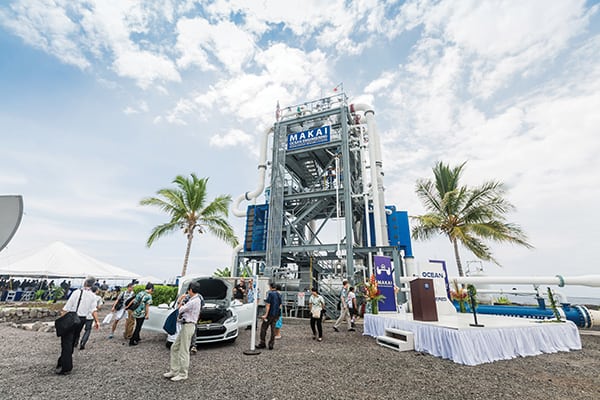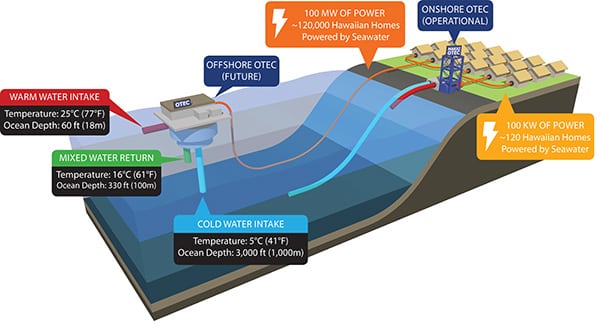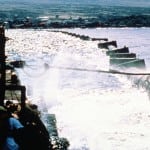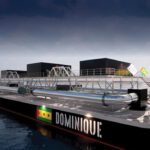One of the world’s largest facilities that harvests energy from ocean temperature gradients began operation this August in Hawaii.
The 100-kW ocean thermal energy conversion (OTEC) facility’s inauguration at the Natural Energy Laboratory of Hawaii Authority (NELHA) marks a significant milestone for the technology (Figure 1). One key aspect being tested at the facility is a heat exchanger. “Heat exchangers make up about [a third] of the cost of a 100-MW OTEC plant,” says developer Makai Ocean Engineering. “Any slight reduction in cost, improvement in efficiency, reduction in size, or extension of life will go a long way towards improving the economics of OTEC.”
 |
| 1. An OTEC Aloha. Makai Ocean Engineering in August celebrated connecting a closed-cycle ocean thermal energy conversion (OTEC) plant to the U.S. grid. Courtesy: Makai Ocean Engineering |
According to the National Renewable Energy Laboratory, on an average day 23 million square miles of tropical seas absorb an amount of solar radiation equal in heat content to about 250 billion barrels of oil—a tenth of which could supply 20 times the power needs of the entire U.S. on any given day. OTEC is a technology that was proposed as far back as 1881 by a French physicist for converting this solar radiation into electrical power. It essentially seeks to exploit the ocean’s thermal gradients—temperature differences of at least 36 degrees F or more between warm surface water and cold deep seawater—to drive a power-producing cycle. OTEC has been proven to provide continuous baseload power as well as fresh drinking water and cold water for refrigeration, but while several prototypes have been tested intermittently since the first experimental 22-kW low-pressure turbine was deployed in 1930, no commercial-scale plants exist.
Over the years, several projects have demonstrated the promising technology’s potential. Japanese researchers, fostered by the Ministry of International Trade and Industry, have built several pilot plants at Saga University on the island of Kyushu. In 2013, their efforts produced a demonstration project consisting of two 50-kW units that use R134a refrigerant as the working fluid. That facility is being used to assess the impacts of variable weather and seawater conditions on plant efficiency. Meanwhile in 2013, South Korea also built a 20-kW pilot plant, with plans to expand it to a 200-kW project.
NELHA’s OTEC test facility is equipped with deep-water pipelines and pump stations and uses ammonia in a closed cycle (Figure 2).
Makai Ocean Engineering, which installed the facility, is under discussion with NELHA to sell excess power at a feed-in-tariff rate of about 19 cents/kWh. Electricity revenues will be used to “sustain further research and development of OTEC technology,” says the firm. Research and development at the plant was funded by the Office of Naval Research through the Hawaii Natural Energy Institute, and the infrastructure was funded by Naval Facilities Engineering Command.
The company eventually wants to put up a 100-MW facility but notes that growth of the world’s small OTEC sector is hampered by high capital costs and problems getting access to financing. “Currently, Makai is aimed at reducing costs and improving the economics of both mid-sized and large-scale offshore OTEC plants,” it said. “In order to attract investments to build a plant of that size, developers will first need to validate the technology of a 5-10 megawatt offshore OTEC plant for several years.”
According to a recent report on ocean energy technology from the European Commission, that project will be one of a handful under development. Others include a 5-MW facility under development in the Bahamas, for which the Bahamas Electricity Corp. has already signed a power purchase agreement; a 1.5-MW project that is being tested on Reunion Island; and a 10-MW onshore plant planned for a large resort on Hainan Island in China by defense firm Lockheed Martin. A 13-MW project planned by the U.S. Navy on Diego Garcia in the Indian Ocean has been stalled. “Economic performance of an OTEC plant will depend very much on its specific configuration and location,” the report’s authors underscored.
—Sonal Patel is a POWER associate editor.











